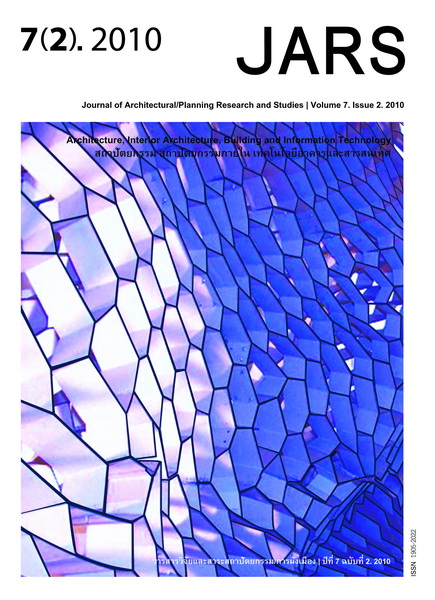Architectural Media and Knowledge Management for Tourism Development: A Case Study of Museum Traveling in Ayutthaya World Heritage Site
Main Article Content
Abstract
Ayutthaya is the most significant root of civilization for the study of architectural and history of
the nation with organizations from both government and private sector in part of management, conservation,
and development, that progress the learning of architectural value and tourism industry, especially in the
potential area of Ayutthaya island. These include the established sources of information and historical
agencies in tourism development, which includes museum, cultural center, information centers, and etc. The
distribution of information is also informed in term of architectural media and data knowledge with two and
three dimensions that provide for learning and education, or visiting the site. However, the quality of learning
content seem to be limited in the learning process which the audience can not have an alternative to access
the area of interest due to the content is determined by organizer’s format. This situation reflects to the media
and data knowledge and the tourism industry development and can not be carried out by the way it should be.
This research had studied on both theories and related issues, focusing on media and data knowledge
development such as data collection and data media of Ayutthaya island. These studies are about transportation,
accessibility, and traveling routes in order to set up the presentation guideline for physical Ayutthaya
island in architectural multimedia and virtual environmental. Especially, the media will provide an option in the
learning process, museum presentation, and alternative of Ayutthaya’s study image such as path, canal, river,
traffic, node, district, landmark, urban, historical site, government agencies, major tourist areas, and etc. This
is to develop and improve way of learning and historical tourism for ancient architecture and its surroundings.
Downloads
Article Details

This work is licensed under a Creative Commons Attribution-NonCommercial-NoDerivatives 4.0 International License.
All material is licensed under the terms of the Creative Commons Attribution 4.0 International (CC-BY-NC-ND 4.0) License, unless otherwise stated. As such, authors are free to share, copy, and redistribute the material in any medium or format. The authors must give appropriate credit, provide a link to the license, and indicate if changes were made. The authors may do so in any reasonable manner, but not in any way that suggests the licensor endorses you or your use. The authors may not use the material for commercial purposes. If the authors remix, transform, or build upon the material, they may not distribute the modified material, unless permission is obtained from JARS. Final, accepted versions of the paper may be posted on third party repositories, provided appropriate acknowledgement to the original source is clearly noted.
References
Bronzetti, V. F. (2006). About VR. Retrieved October 27, 2009, from http://www.fabricat.com/PDF_FILES/About%20VR.pdf
Horayangkura, V. (1992). พฤติกรรมมนุษย์กับสภาพแวดล้อม [Human behavior and environment] (3rded.). Bangkok, Thailand: Chulalongkorn University Press.
Horayangkura, V. (2009). In search of sustainable paradigms for conservation and development based on underlying convergent/divergent conceptions. Journal for Architectural/Planning Research and Studies 6(3), 3-21.
Jongkol, J.* (1989). พิพิธภัณฑสถานวิทยา [Museum science] (2nd ed.). Bangkok, Thailand: Amarin Printing Group.
Kulchol, K.* (2002). การออกแบบชุมชนเมืองคืออะไร: การติดตามหาคำาตอบในรอบ 40 ปี [What is urban design?: The Following answers in the past 40 years]. Bangkok, Thailand: Faculty of Architecture, Silpakorn University.
Letellier, R. (1999). Virtual Reality: A new tool for sustainable tourism and cultural heritage sites management. Retrieved October 22, 2009, from http://cipa.icomos.org/fileadmin/papers/olinda/99c102.pdf
Miryang City - VR Gallery. (2009). Retrieved October 28, 2009, from http://eng.miryang.go.kr/program_/vr/list.php
Planning Division. (1997). สรุปคู่มือการพัฒนาแหล่งท่องเที่ยวทางด้านกายภาพ: เอกสารประกอบการวางแผนการท่องเที่ยว เล่มที่ 10 [Summary guide the physical development of tourism documents for travel planning, volume 10]. Bangkok, Thailand: Tourist Authority of Thailand.
QuickTime VR. (2009). Retrieved October 21, 2009, from http://en.wikipedia.org/wiki/Quicktime_vr
Shenchang, E. C. (2002). QuickTime VR – An Image-Based Approach to Virtual Environment Navigation. Retrieved October 22, 2009, from http://www1.cs.columbia.edu/~ravir/6998/papers/p29-chen.pdf
Travel and Tourism. (2009). Retrieved October 27, 2009, from http://www.virtually-anywhere.com/tourism/index.html
The Venetian - Photos and Tour. (2009). Retrieved October 28, 2009, from http://www.venetian.com/PagesIf.aspx?id
The Westin Chosun Hotel VR. (2009). Retrieved October 28, 2009, from http://www.echosunhotel.com/General/lib/flash/vr/main.htm
Virtually Anywhere. (2009). Retrieved October 27, 2009, from http://www.virtually-anywhere.com
VR Tourism. (2009). Retrieved October 27, 2009, from http://www.vrac.iastate.edu/press/PDFs/2003_VRtourism.pdf
Virtual tour. (2009). Retrieved October 21, 2009, from http://en.wikipedia.org/wiki/Virtual_tour
Virtual Tours for Real Industries. (2009). Retrieved October 27, 2009, from http://www.virtually-anywhere.com/industries/index.html
VR Photogtaphy. (2009). Retrieved October 21, 2009, from http://en.wikipedia.org/wiki/VR_photography
Wikipedia. (2009a). ความเป็นจริงเสมือน [Virtual reality]. Retrieved June 1, 2009, from http://th.wikipedia.org/wiki/ความเป็นจริงเสมือน
Wikipedia. (2009b). Virtual reality. Retrieved June 6, 2009 from http://en.wikipedia.org/wiki/Virtual_reality


